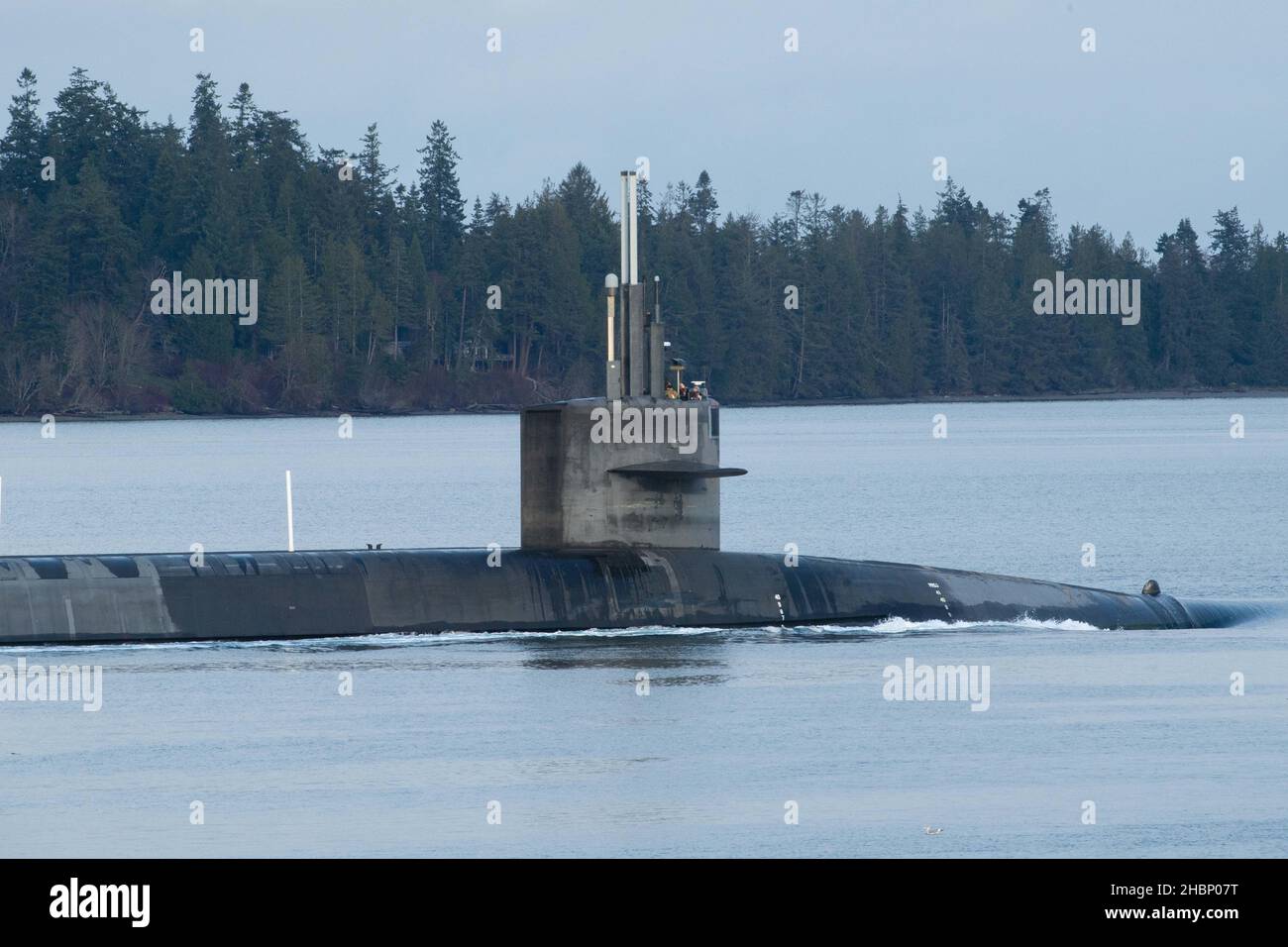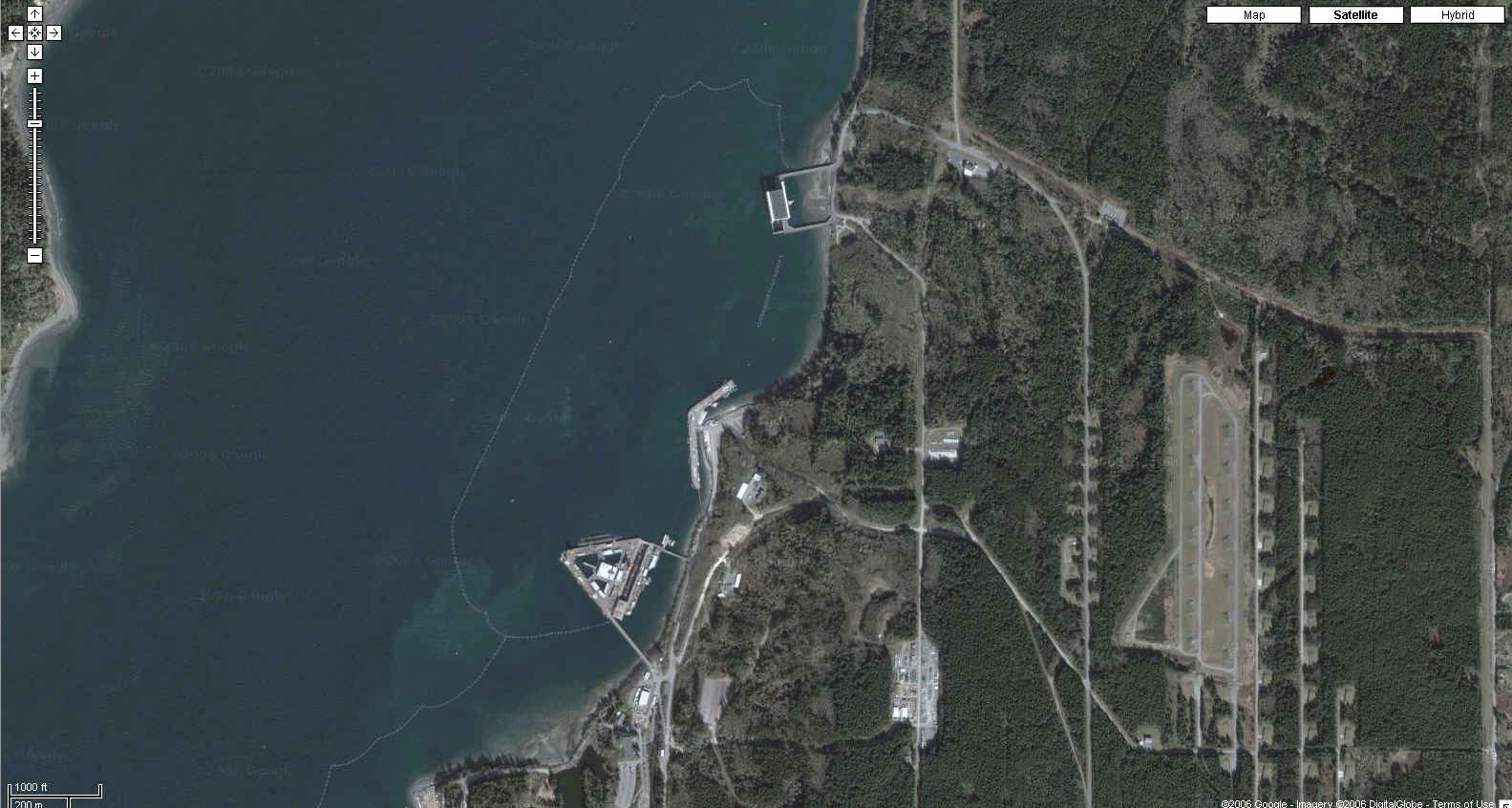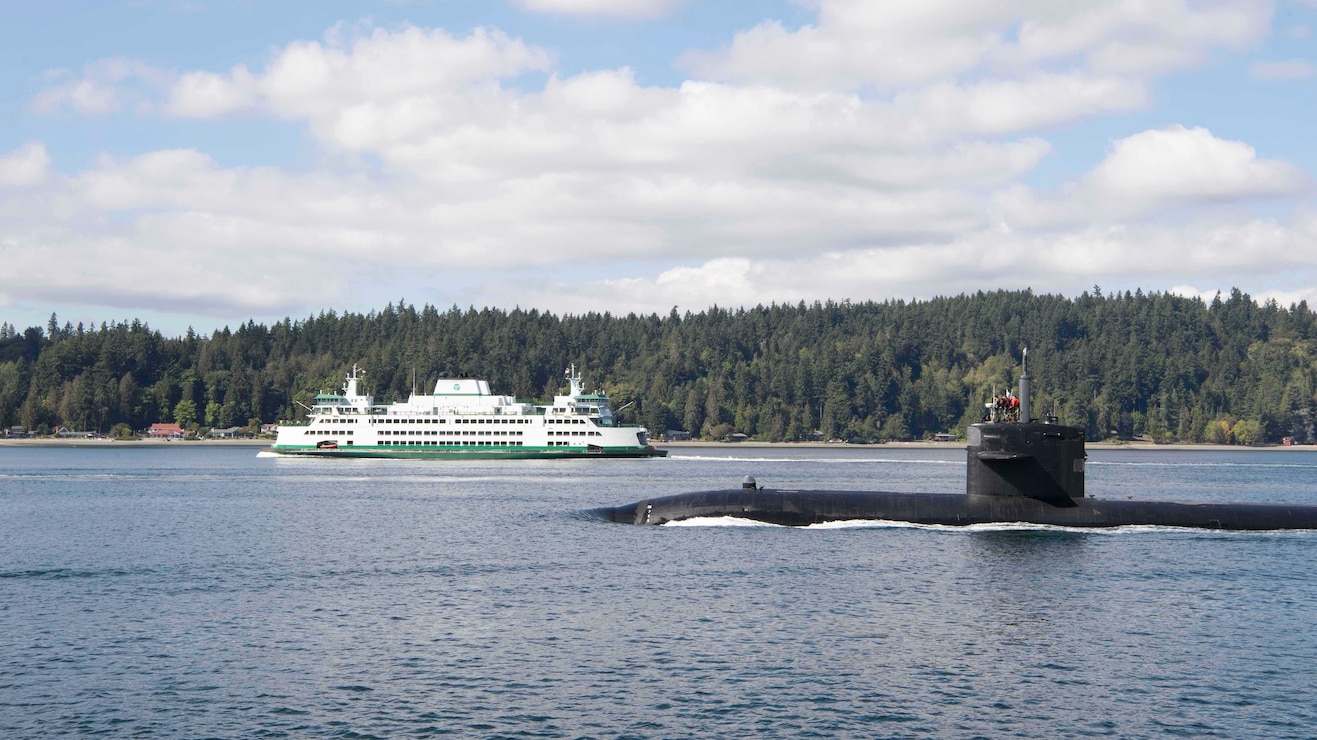Bangor Wa Sub Base - 47°43′27.84″N 122°43′12.17″W / 47.7244000°N 122.7200472°W / 47.7244000; -122.7200472 Coordinates: 47°43′27.84″N 122°43′12.17″W / 47.7244000°N 122.7200472°W / 47.7244000; -122.720472
Naval Submarine Base Bangor with the tug Mishawaka (left behind) and three other tugs of the Natick-class USS Ohio
Bangor Wa Sub Base

Bangor Naval Submarine Base is a former United States Navy submarine base that merged with Naval Station Bremerton into Naval Base Kitsap in 2004.
Naval Base Kitsap, Washington
Naval Support Base Bangor began in 1942, where it housed armor for the Pacific Theater of Operations during World War II. To expand and stabilize the naval base, the US Navy purchased 7,676 acres (3,100 hectares) of land on Hood Canal near the town of Bangor, Washington for approximately $18.7 million. We The naval emporium was established on June 5, 1944, and its construction and operations began in January 1945.
Beginning in World War II, and through the Korean War and Vietnam, until January 1973, the Bangor Annex continued its service in the US. Naval Ammunition Depot responsible for shipping conventional weapons overseas.
In 1973, the Navy announced the selection of the Bangor base as the home port of the first fleet of Ohio-class Tridt Ballistic Missile Submarines. On February 1, 1977, Tridt Submarine Base became official. Naval Base Kitsap includes the Strategic Weapons Facility Pacific (SWFPAC) which provides maintenance, calibration, missile assembly/test, spare parts, and nuclear warhead storage for the UGM-133 Tridt II submarine-launched nuclear-capable ballistic missile.
This is the only Tridt submarine base for the US Pacific Fleet, including the Tridt submarine base at Kings Bay, Georgia for the US. The Atlantic Fleet is the only one.
Rental Homes And Townhomes
Marine Corps Security Forces Battalion Bangor has protected ballistic missile submarines and provided infrastructure since the first security unit, an average company, was chartered in October 1978 and joined in June 2004. The new command was named Naval Base Kitsap.
We Naval Submarine Base (SUBASE), Bangor on the eastern shore of Hood Canal. The base pillar facilities are located in two nmi. The main facilities at SUBASE Bangor consist of four separate complexes: "KB" Docks, Delta Pier, Marginal Pier, and Explosives Handling Wharf. Trident submarines berth at Marginal Pier South and Delta Pier North and South. They also use explosives in the warehouse and in the drydock at Delta Pier. According to harbor authorities, submarines rarely nest, and when they do, they only nest for one or two days. The piers have a nominal height above average of 20 fl below the lower water. The water depth varies from 45 ft at the North and South Marginal Wharves, to 60 to 115 ft at the Delta Piers.
The main facilities at SUBASE Bangor consist of four separate complexes: "KB" Docks, Delta Pier, Marginal Pier, and Explosives Handling Wharf. Trident submarines berth at Marginal Pier South and Delta Pier North and South. They also use explosives in the warehouse and in the drydock at Delta Pier. According to harbor authorities, submarines rarely nest, and when they do, they only nest for one or two days. The piers have a nominal height above average of 20 fl below the lower water. The water depth varies from 45 ft at the North and South Marginal Wharves, to 60 to 115 ft at the Delta Piers.

No stations exist at SUBASE Bangor. Boat hire is available for hire near the KB shipyards. SUBASE Bangor has three 2,000 hp YTB tugboats and one twin screw 1,600 hn commercial tug. The local authorities claim that the pilots are used for all the arrivals in Bangor's submarines. At any point in the field from Bad Weather to the mouth of Hood Canal southward to outside Bangor, the pilots picked up the savages. If the submarine officer passes the Hood Canal bridge once, the pilot is free to leave. If towing assistance is required, maneuvering must be done
Special Warfare Personnel Test Positive For Covid 19 At Bangor Navy Base
Southerly winds directly affect the port of Bangor due to the orientation of the Hood Canal. Winds are strengthened and blown eastward across the channel by the tension of the channel relative to the adjacent areas. Explosive operations at the Wharf, the Delta Drydock Handling, and the Silent Magnetic Facility will cease if the wind speed reaches 25 kt. The wind alone does not prevent submarines from being towed, but causes the waves to wash over their hulls.
KB Docks are small craft used by the Naval Undersea Weapons Engineering Station (NUWES) in Keyport. Bengor harbor pilots declare that the lines have been doubled and that dead men's lines and anchors have been used to prevent excessive movement of the moored ships in the strong southerly winds. Most of the vessels were stationed inside the side of the pier, but the YTT (receiver torpedo boats - 135-140 ft long/1,600 tons) hang outside the openings and are not exposed to any conditions existing in Hood Canal.
The only hazard identified at SUBASE Bangor is a strong southwesterly wind blowing through Hood Canal. Due to the low profile of the hull, the wind poses no direct threat to submarines. However, this may affect the ability of tugs to operate submarines from the region. It will also affect vessel and YTT operations from NUWES Keyport, which use the KB Dock complex. Whenever winds approach 50 kt, the Hood Canal Bridge is closed to vehicular traffic and kept in an open position to reduce wind stress on the bridge structure. The floating bridge was partially destroyed by wind/waves on February 13, 1979 during a severe storm.
South berth Delta Pier and KB piers experienced four to six foot swells in high (up to 60 kt) winds. While access to submarine hulls is blocked, submarine waves do not directly cause problems. However, if you tow next to a submarine, the shock wave can rise and fall with potential damage to the submarine's stern. To prevent such damage, normal towing operations are suspended during high wind conditions.
Officials Working To Clean Up Diesel Fuel Spill At Naval Base Kitsap Bangor
The flow in Hood Canal, a semi-enclosed basin, is generally tidal. In the north westerly flow of 1.0 to 1.2 kt is almost adjacent to the subASE. Because of the steep terrain on both sides of Hood Canal, heavy rains cause heavy runoff. The increased runoff adds to the tidal flow in the approach, increasing the current speed to two kl. Local authorities say submarines leaving their berth south of the Delta Pier during high tides have great difficulty moving upriver and off the pier. South flood flows are typically in the 0.6 to one kt range.
The Navy plans to call for POLAR FBM submarines to operate in the Pacific. Accordingly, the DoD announced, on April 23, 1962, the selection of various POLAR support facilities in the Pacific. Puget Naval Shipyard in Bremerton, Washington, has been selected as the FBM submarine overhaul facility; in Bangor, Washington, was selected for the POLARIS missile facility; Pearl Harbor, Hawaii, has been selected as the crew's training facility. Construction of the facility in Bangor cost $12.5 million in March 1963. On September 1, 1963, the missile facility was designated as a state of progress and on September 11, 1964, the POLARIS Missile Facility, Pacific (POMFPAC) was assigned to the Navy. Ammunition Depot, Bangor, Washington.
Bangor is located on the Kitsap Peninsula on the shores of Hood Canal. The base comprises 7,676 hectares of land, of which 5,000 are forested. Bangor is home to a natural herd of deer, many bears, and many other wild animals. The Olympic mountains provide a beautiful backdrop for the base.
POMFPAC made its first tactical offload of POLAR A3 missiles on USS Stonewall Jackson (SSBN-634) on 26 March 1965, and the submarine began patrol operations on 9 April 1965.
Naval Sub Base Bangor Enlisted Ball Cap
POMFPAC began converting POLARIS (A3's) to ANTELOPE (A3T) configuration in August 1970 and completed the Pacific Antelope Conversion Program in February 1972.
The IDA 1967 STRAT-X Report, in addition to proposing a new ULMS submarine and missile, also proposed concepts for the ULMS Refit complex. In order to assess the feasibility of the concept, the SSPO Director of the CNM Office initiated, organized and coordinated the ULMS Refit Complex Study. The purpose of the study, begun in November 1970, was to determine the feasibility, size of the complex, land, personnel, and resources needed in dollars as well as to evaluate and recommend locations in the Atlantic and Pacific.
The main objective of the ULMS Refit Complex is to improve the utilization rate (circuit availability) of SSBNs. The utilization rate depends on the multiple replenishment capabilities and the compatible SSBN design. The location of the replenishment along with the missile capability is the percentage of missiles "ready" in a prompt response mode. The new ULMS missiles are extended
Bangor naval base housing, sub base bangor, bangor submarine base wa, bangor base housing, bangor washington naval base housing, base housing bangor wa, bangor wa naval base, bangor wa navy base, sub base bangor washington, military housing bangor wa, naval sub base bangor wa, bangor base wa

0 Comments